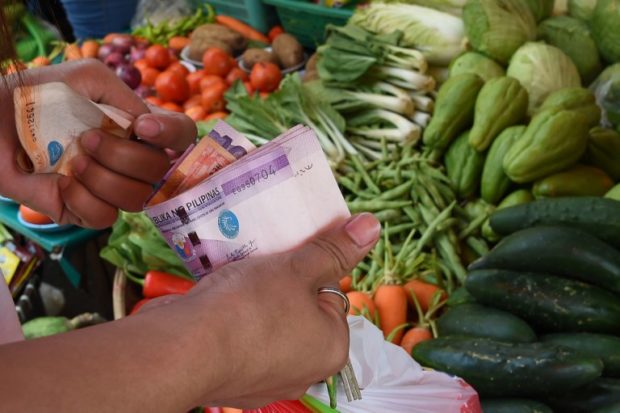Inflation slowed down to 6.1% in May

A customer buys vegetables at a market in Manila on October 5, 2018. – Philippine inflation has risen for a ninth straight month in September, to a near-10-year high, the government said October 5, in an unexpected challenge for President Rodrigo Duterte. (Photo by TED ALJIBE / AFP)
The rate of increase in the prices of goods and services that households commonly purchase slowed down as expected for the fourth month in a row to 6.1 percent in May, according to the Philippine Statistics Authority (PSA).
The readout for May is the slowest in 10 months or since July 2022, but slightly faster than analysts’ common forecast of 6 percent for the month.
Also, the latest inflation print was slower than the 6.6 percent recorded in April and came in below the Bangko Sentral ng Pilipinas’ (BSP) projection 6.2 percent.
However, it was still faster than the 5.4 percent recorded in May last year.
National Statistician Dennis Mapa said in a press briefing the lower headline inflation was mainly due to slower increases in prices of gasoline, diesel, road transport fares, fish and meat like chicken as well as of restaurants and accommodation services.
For the five months from January to May, inflation averaged at 7.5 percent, which was still way above the government’s target range of 2 percent to 4 percent.
Analysts say the continued loss of inflation steam was not enough to prompt a reduction of the central bank’s policy rate, which is currently at 6.25 percent.
Second-order effects
The BSP said it stood ready to adjust the monetary policy stance as needed, to prevent the further broadening of price pressures as well as the emergence of additional so-called second-order effects—such as increases in transport fares and wages.
The economic research team at Bank of the Philippine Islands (BPI) maintained their view that a policy rate cut is premature at this time, especially considering the possibility of another rate hike by the United States Federal Reserve.
“The recent GDP (gross domestic product) data have shown that demand remains strong and the economy doesn’t need additional stimulus,” BPI said, referring to the 6.4-percent economic growth rate in the first quarter.
BSP target
“The more crucial objective now is to ensure that inflation goes back to the BSP’s target,” BPI said. “Achieving this is a growth stimulus in itself, making the stimulus provided by rate cuts unnecessary at this point.”
The Netherlands-based ING Bank agrees, saying that moderating headline inflation gives the BSP space to maintain policy settings.
“[H]owever, we don’t expect central banks to consider cutting rates just yet given the pressure on their respective currencies,” ING Bank said.
New York-based Goldman Sachs also agrees, noting that both food inflation as well as core inflation—which excludes food and energy whose prices change more quickly than other items—declined in May.
“Going forward, as inflation pressures ease, we continue to expect BSP to keep its policy rate unchanged for the remainder of the year,” the American group said.
On the other hand, frequent outlier and United Kingdom-based Pantheon Macroeconomics believes that the BSP policy rate will be unchanged through the third quarter and then decrease to 5.75 percent by the end of this year.
“Overall, our inflation forecast implies that the headline rate will return to within the BSP’s 2 percent to 4 percent target range in September, opening the door for the 50 basis point-worth of rate cuts we expect in the fourth quarter,” they added. INQ
